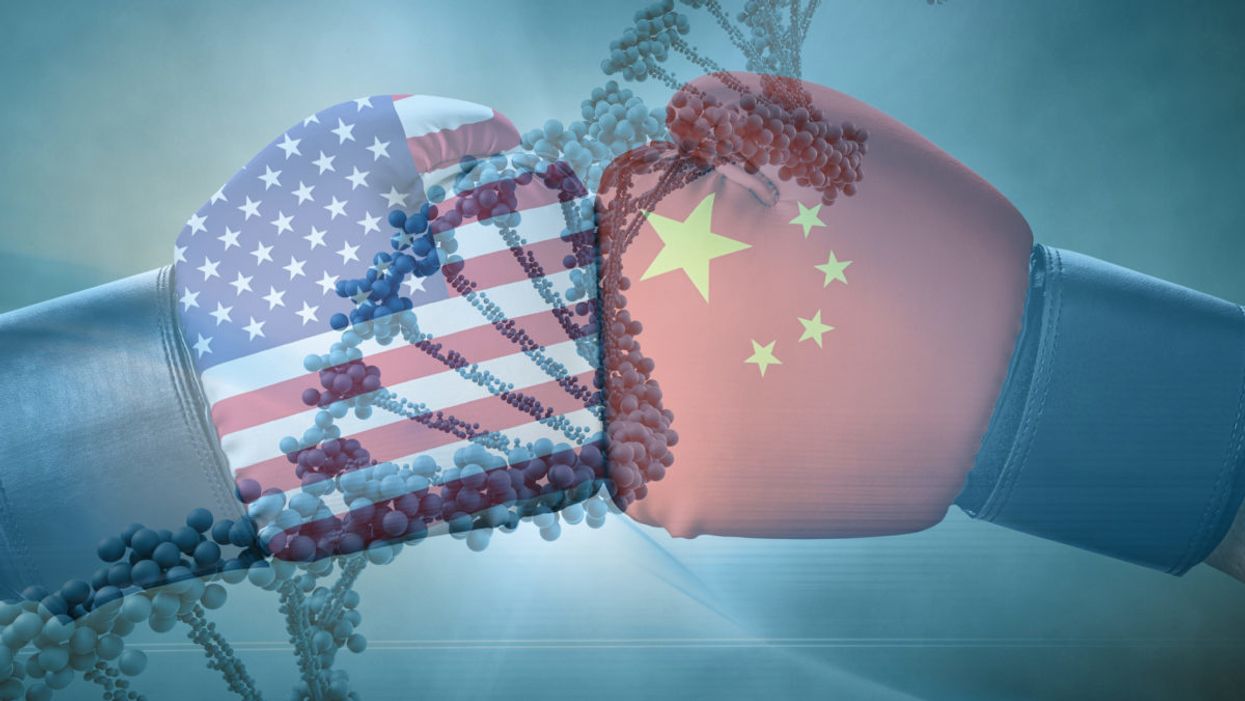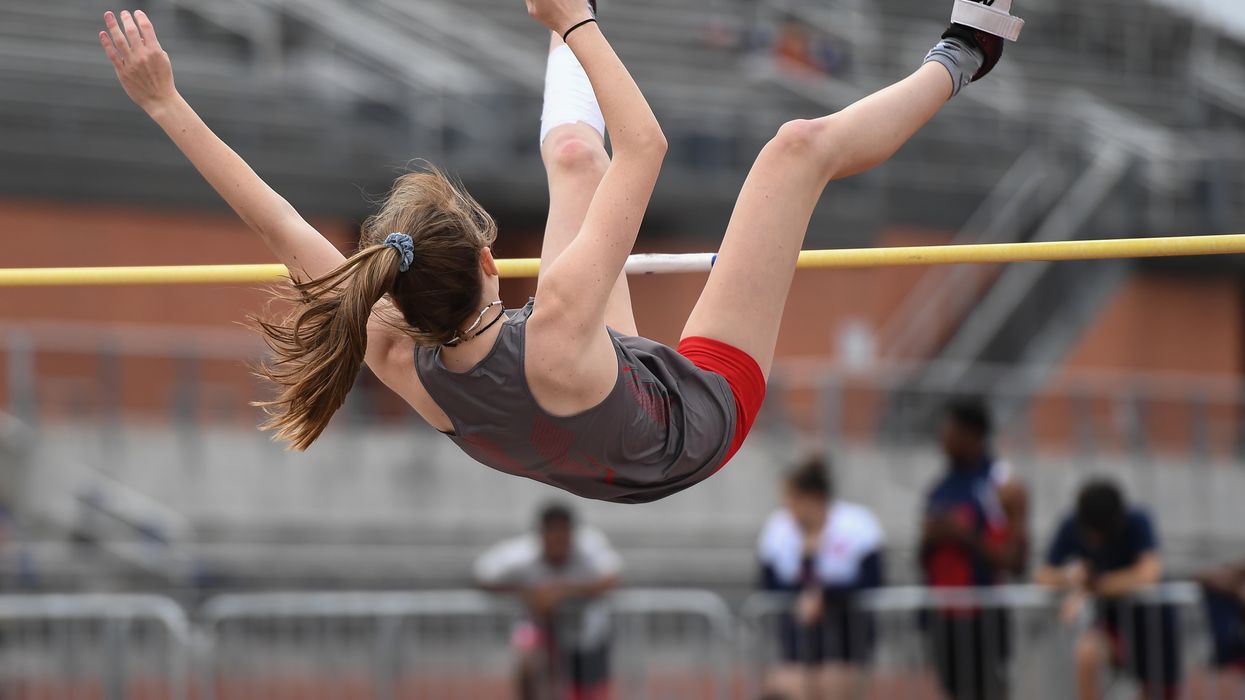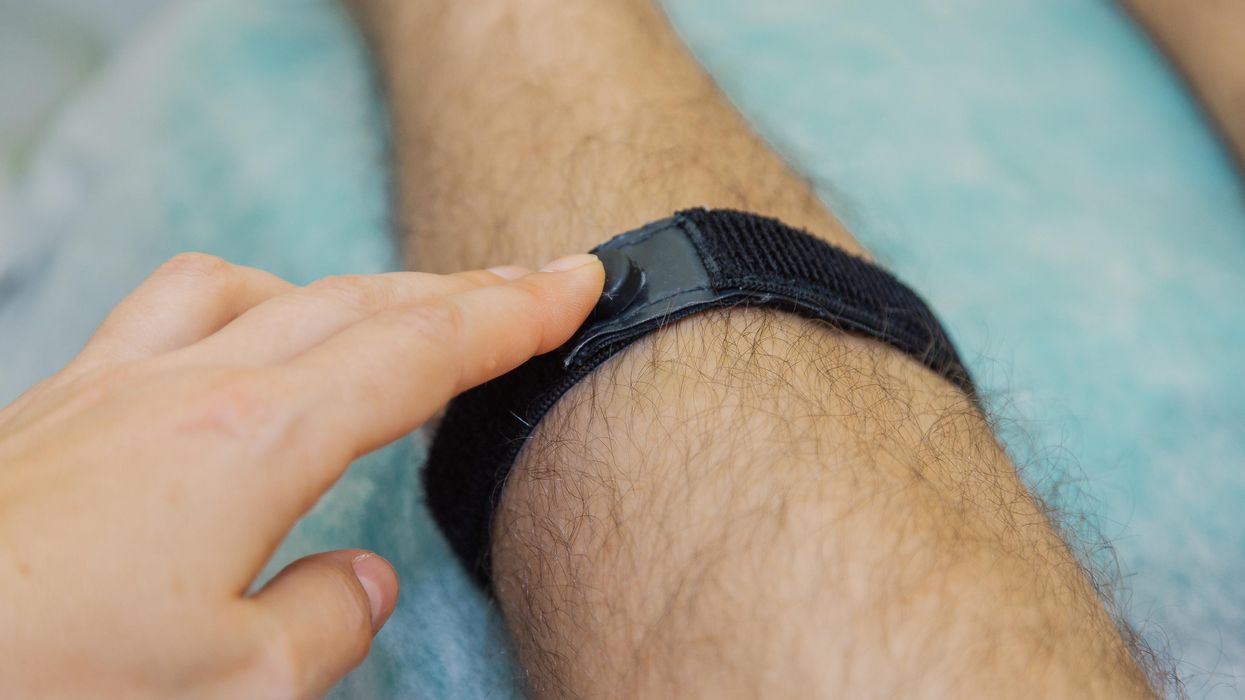China vs. the West: Who Will Lead the Way in Embryo Editing Research?

The U.S. metaphorically boxing with China over biomedical research.
Junjiu Huang and his team performed a miracle. A few miracles, actually. The researchers at Sun Yat-sen University in Guangzhou, China used the precise new DNA editing tool called CRISPR-CAS9 to edit a human embryo, replacing a single base. In doing so, they edited out beta-thalassemia, a blood disorder that reduces the production of hemoglobin, which can result in pale skin, fatigue, higher risk of blood clots, and other symptoms.
The race is on, and it's one everyone is going to try to win.
Huang's group, which did not respond to an email requesting comment for this story, injected 86 embryos and observed them for 48 hours. After that period -- a time long enough for CRISPR to split the DNA, other molecules to replace the base, and the embryos to grow to eight cells -- they tested 54 of the 71 that survived. Of those, only a few had the replacement base, according to a report of the study published in Protein & Cell. The experiment stopped there as the embryos, which had been acquired from local fertility clinics, were non-viable and not implanted.
But procreation was not the point. Far from it, in fact. The point was to demonstrate that it could be done, that in some far off (or not so far off) future, doctors could use CRISPR to eliminate diseases like Tay-Sachs, Huntington's, and cystic fibrosis that are caused by genetic mutations. Going a step further, perhaps they could eventually even tailor embryos that will develop into adults with specific traits like height and IQ.
Experts agree that we are far from that point, years if not decades away from leveraging CRISPR to cure diseases and decades if not centuries from being able to build designer babies. In that frame, Huang's achievement is just a small step, a blip on the timeline of human achievement. But seen in another light, it's yet another sign that we need to start talking about DNA modification now, establishing protocols, procedures, and plans that guide the subject before we get so far down the road that momentum is impossible to stop.
"The Chinese generally don't have the religious objections to embryo research that have held back research in the West."
It's essential to do so now because the idea of DNA modification -- a realization that humanity can control its evolution -- is compelling and attractive. Imagine a world where doctors and scientists could get rid of disease before it begins or ensure a baby would arrive with an Einstein-level IQ. That's intriguing, and also terrifying. What are the rules? How do we know when to stop? What guides the process? And how can we prevent mistakes or unwanted mutations? To borrow from another famous quotation, with great power comes great responsibility.
These aren't questions for Huang and the Chinese scientific community alone. A team from Oregon recently edited viable human embryos, eliminating a mutation that can lead to heart failure while preventing any unintended consequences. Just as importantly, every embryo they edited produced the intended genetic changes, a vital step since a partial success rate, known as mosaicism, could have devastating consequences to a future child.
In London at the Francis Crick Institute, researcher Kathy Niakan used CRISPR-CAS9 to "turn off" a gene that produces the protein OCT4. Without the protein, the fertilized egg could not produce a blastocyst, which is a key structure in early mammalian development that gives rise to an embryo and placenta. The recent study wasn't designed to go further, but the use of CRISPR was important. "One way to find out what a gene does in the developing embryo is to see what happens when it isn't working," said Dr. Niakan, who was the first scientist in the world to be granted regulatory approval to edit the genes of a human embryo for research. "Now that we have demonstrated an efficient way of doing this, we hope that other scientists will use it to find out the roles of other genes. If we knew the key genes that embryos need to develop successfully, we could improve IVF treatments and understand some causes of pregnancy failure. It may take many years to achieve such an understanding. Our study is just the first step."
The point is, CRISPR is here and it's not going anywhere. Scientists will continue to use it to learn about how humans develop. Yet different rules regarding CRISPR and embryo research in countries around the world will impact who gets there first. "I've heard the U.S.-China gene editing research parallel paths as Sputnik 2.0," said Kevin Doxzen, Science Communications Specialist at the University of California, Berkeley's Innovative Genomics Institute. The race is on, and it's one everyone is going to try to win.
Based on number of researchers and ease of regulations, the Chinese are the favorites to advance the science the furthest, the fastest.
Based on number of researchers and ease of regulations, the Chinese are the favorites to advance the science the furthest, the fastest. "The Chinese generally don't have the religious (predominantly Christian) or moral objections to embryo research that have held back research in the West," said Dr. Julian Savulescu, the Uehiro Professor of Practical Ethics and Director of the Oxford Martin Programme on Collective Responsibility for Infectious Disease at the University of Oxford. "This kind of research should be done, with the right sort of ethical oversight. The concern over China leading the way is that institutional oversight mechanisms are probably not as developed as in the West but so far, there is no evidence of breaches in standards of research ethics around the published research."
Or, put another way by bioethicist Dr. Arthur Caplan, founding director of NYU Langone Health's Division of Medical Ethics: "The Chinese, because they don't care and don't have moral reservations about embryo work, are doing what they want." This lack of aversion to working with embryos manifests itself in a couple of ways. The absence of moral qualms is one. Funding is another. Huang's study, and others like it, receive funding from the government. His, for example, was supported by two grants from the National Basic Research Program and three from the National Natural Science Foundation of China.
The U.S., on the other hand, bans any federal funding for research using human embryos. A law passed in 1996 states that federal dollars can't be used for: "research in which a human embryo or embryos are destroyed, discarded, or knowingly subjected to risk of injury or death greater than that allowed for research on fetuses." This restriction can shift incentives as many private institutions or commercial enterprises may have financial motivations or other goals beyond furthering basic research for the sake of general knowledge.
Embryo gene modification recently performed in the U.K. would merit 15 years in prison in Australia.
The embryo research ban is even more strict elsewhere. The Oviedo Convention, enacted in 1997, effectively prohibits germline engineering in members of the European Union. "In Italy, you can't destroy an embryo for any reason," said Alessandro Bertero, a postdoctoral fellow at the University of Washington's Department of Pathology who used to study in Italy. "It's illegal, and you'll go to jail." Later, Bertero was one of the researchers who worked with Dr. Niakan in London, an investigation that was allowed by the UK's Human Fertilisation and Embryology Authority. (In Australia, Niakan and her colleagues would face 15 years in jail due to the 2002 Prohibition of Human Cloning Act, which prohibits altering the genomes of embryonic cells.)
Despite the moral and legal reservations in the Western world, every person I spoke with for this story believed that better, more advanced studies and learning is happening in the U.S. and Europe. "The best studies in my opinion are from the labs in California and Oregon," Bertero said. "The quality of the work [in the Chinese study] – not being critical, but to be scientifically critical -- was just quick and dirty. It was, 'Let's just show that we have done it and get it out.' That doesn't mean that the quality of the work was good."
"If the Chinese or someone else starts beating our brains out, we're not going to want to stand by idly and not do these things."
How long that remains the case, however, is an open question. A significant number of groups in China are working on germline editing in human embryos. The concern is that the Chinese will emerge as a leader sooner rather than later because they can do research with embryos more easily than their Western counterparts.
For Caplan, the NYU professor, the embryo ban in the U.S. isn't based on science; it's rooted in something else. "It's 96 percent political," he said, laughing. "It has basically ground to a halt because no one wants to see repercussions take place if federal funding is involved. The NIH isn't involved. And they won't be."
What, in his mind, would get Americans to start realizing the benefits that embryo research would provide? "The perception that other countries were moving quickly to get the advantages of CRISPR and other gene modification techniques, finding more industrial and more medical purposes," he said. "If the Chinese or someone else starts beating our brains out, we're not going to want to stand by idly and not do these things."
Doing so would involve difficult conversations about the role of embryos in research. But these are philosophical questions that need to be approached at some point. From a U.S. perspective, doing so sooner while the American scientists still hold the technological and informational edge, is vital. Ignoring the issue doesn't make it go away.
Experts think a few changes should be made. The ban on federal funding should be lifted. Scientists and regulators should push for things like allowing federal funds to be used for the creation of new embryos for research purposes and the use of spare IVF embryos for research when the embryo would not be implanted into a woman. (Privately funded scientists can proceed in states that encourage embryonic stem cell research, like New York, New Jersey, and California, but not in restrictive ones like Louisiana and South Dakota, which prohibit creating or destroying embryos for research.) Policymakers could ban reproductive gene editing for now but look at it again after a certain period. A highly anticipated report issued earlier this year from an international guidance committee left the door open to eventual clinical trials with edited embryos. As of now, however, Congress will not allow the Food and Drug Administration to consider such trials. This is the future and it's the scientific community's responsibility to develop the ethical framework now.
"The US and Europe have the technological history and capacity to lead this research and should do so, ethically. We ought to be revising our laws and ethical guidelines to facilitate this kind of research," Professor Savulescu said. "But the challenge is to think constructively and ethically about this new technology, and to be leaders, not followers."
Debates over transgender athletes rage on, with new state bans and rules for Olympians, NCAA sports
Some argue that transgender females should be banned from competing with women in sports, while others think such bans are unfair, as the NCAA and other organizations try to keep up with research on how testosterone affects performance.
Ashley O’Connor, who was biologically male at birth but identifies as female, decided to compete in badminton as a girl during her senior year of high school in Downers Grove, Illinois. There was no team for boys, and a female friend and badminton player “practically bullied me into joining” the girls’ team. O’Connor, who is 18 and taking hormone replacement therapy for her gender transition, recalled that “it was easily one of the best decisions I have ever made.”
She believes there are many reasons why it’s important for transgender people to have the option of playing sports on the team of their choice. “It provides a sense of community,” said O’Connor, now a first-year student concentrating in psychology at the College of DuPage in Glen Ellyn, Illinois.
“It’s a great way to get a workout, which is good for physical and mental health,” she added. She also enjoyed the opportunity to be competitive, learn about her strengths and weaknesses, and just be normal. “Trans people have friends and trans people want to play sports with their friends, especially in adolescence,” she said.
However, in 18 states, many of which are politically conservative, laws prohibit transgender students from participating in sports consistent with their gender identity, according to the Movement Advancement Project, an independent, nonprofit think tank based in Boulder, Colo., that focuses on the rights of LGBTQ people. The first ban was passed in Idaho in 2020, although federal district judges have halted this legislation and a similar law in West Virginia from taking effect.
Proponents of the bans caution that transgender females would have an unfair biological advantage in competitive school sports with other girls or women as a result of being born as stronger males, potentially usurping the athletic accomplishments of other athletes.
“The future of women’s sports is at risk, and the equal rights of female athletes is being infringed,” said Penny Nance, CEO and president of Concerned Women for America, a legislative action committee in D.C. that seeks to impact culture to promote religious values.
“As the tidal wave of gender activism consumes sports from the Olympics on down, a backlash is being felt as parents are furious about the disregard for their daughters who have worked very hard to achieve success as athletes,” Nance added. “Former athletes, whose records are being shattered, are demanding answers.”
Meanwhile, opponents of the bans contend that they bar transgender athletes from playing sports with friends and learning the value of teamwork and other life lessons. These laws target transgender girls most often in kindergarten through high school but sometimes in college as well. Many local schools and state athletic associations already have their own guidelines “to both protect transgender people and ensure a level playing field for all athletes,” according to the Movement Advancement Project’s website. But statewide bans take precedence over these policies.
"It’s easy to sympathize on some level with arguments on both sides, and it’s likely going to be impossible to make everyone happy,” said Liz Joy, a past president of the American College of Sports Medicine.
In January, the National Collegiate Athletic Association (NCAA), based in Indianapolis, tried to sort out the controversy by implementing a new policy. It requires transgender students participating in female sports to prove that they’ve been taking treatments to suppress testosterone for at least one year before competition, as well as demonstrating that their testosterone level is sufficiently low, depending on the sport, through a blood test.
Then, in August, the NCAA clarified that these athletes also must take another blood test six months after their season has started that shows their testosterone levels aren’t too high. Additional guidelines will take effect next August.
Even with these requirements, “there is no plan that is going to be considered equitable and fair to all,” said Bradley Anawalt, an endocrinologist at the University of Washington School of Medicine. Biologically, he noted, there is still some evidence that a transgender female who initiates hormone therapy with estrogen and drops her testosterone to very low levels may have some advantage over other females, based on characteristics such as hand and foot size, height and perhaps strength.
Liz Joy, a past president of the American College of Sports Medicine, agrees that allowing transgender athletes to compete on teams of their self-identifying gender poses challenges. “It’s easy to sympathize on some level with arguments on both sides, and it’s likely going to be impossible to make everyone happy,” said Joy, a physician and senior medical director of wellness and nutrition at Intermountain Healthcare in Salt Lake City, Utah. While advocating for inclusion, she added that “sport was incredibly important in my life. I just want everyone to be able to benefit from it.”
One solution may be to allow transgender youth to play sports in a way that aligns with their gender identity until a certain age and before an elite level. “There are minimal or no potential financial stakes for most youth sports before age 13 or 14, and you do not have a lot of separation in athlete performance between most boys and girls until about age 13,” said Anwalt, who was a reviewer of the Endocrine Society’s national guidelines on transgender care.
Myron Genel, a professor emeritus and former chief of pediatric endocrinology at Yale School of Medicine, said it’s difficult to argue that height gives transgender females an edge because in some sports tall women already dominate over their shorter counterparts.
He added that the decision to allow transgender females to compete with other girls or women could hinge on when athletes began taking testosterone blockers. “If the process of conversion from male to female has been undertaken in the early stages of puberty, from my perspective, they have very little unique advantage,” said Genel, who advised the International Olympic Committee (IOC), based in Switzerland, on testosterone limits for transgender athletes.
Because young athletes’ bodies are still developing, “the differences in natural abilities are so massive that they would overwhelm any advantage a transgender athlete might have,” said Thomas H. Murray, president emeritus of The Hastings Center, a pioneering bioethics research institute in Garrison, New York, and author of the book “Good Sport,” which focuses on the ethics and values in the Olympics and other competitions.
“There’s no good reason to limit the participation of transgender athletes in the sports where male athletes don’t have an advantage over women,” such as sailing, archery and shooting events, Murray said. “The burden of proof rests on those who want to restrict participation by transgender athletes. They must show that in this sport, at this level of competition, transgender athletes have a conspicuous advantage.”
Last year, the IOC issued a new framework emphasizing that the Olympic rules related to transgender participation should be specific to each sport. “This is an evolving topic and there has been—as it will continue to be—new research coming out and new developments informing our approach,” and there’s currently no consensus on how testosterone affects performance across all sports, an IOC spokesperson told Leaps.org.
Many of the new laws prohibiting transgender people from competing in sports consistent with their gender identity specifically apply to transgender females. Yet, some experts say the issue also affects transgender males, nonbinary and intersex athletes.
“There has been quite a bit of attention paid to transgender females and their participation in biological female sports and almost minimal focus on transgender male competition in male sports or in any sports,” said Katherine Drabiak, associate professor of public health law and medical ethics at University of South Florida in Tampa. In fact, “transgender men, because they were born female, would be at a disadvantage of having less lean body mass, less strength and less muscular area as a general category compared to a biological male.”
While discussing transgender students’ participation in sports, it’s important to call attention to the toll that anti-transgender legislation can take on these young people’s well-being, said Jonah DeChants, a research scientist at The Trevor Project, a suicide prevention and mental health organization for LGBTQ youth. Recent polling found that 85 percent of transgender and nonbinary youth said that debates around anti-transgender laws had a negative impact on their mental health.
“The reality is simple: Most transgender girls want to play sports for the same reasons as any student—to benefit their health, to have fun, and to build connection with friends,” DeChants said. According to a new peer-reviewed qualitative study by researchers at The Trevor Project, many trans girls who participated in sports experienced harassment and stigma based on their gender identity, which can contribute to poor mental health outcomes and suicide risk.

In addition to badminton, O'Connor played other sports such as volleyball, and she plans to become an assistant coach or manager of her old high school's badminton team.
Ashley O'Connor
However, DeChants added, research also shows that young people who reported living in an accepting community, had access to LGBTQ-affirming spaces, or had social support from family and friends reported significantly lower rates of attempting suicide in the past year. “We urge coaches, educators and school administrators to seek LGBTQ-cultural competency training, implement zero tolerance policies for anti-trans bullying, and create safe, affirming environments for all transgender students on and off the field,” DeChants said.
O’Connor said her experiences on the athletic scene have been mostly positive. The politics of her community lean somewhat liberal, and she thinks it’s probably more supportive than some other areas of the country, though she noted the local library has received threats for hosting LGBTQ events. In addition to badminton, she also played baseball, lacrosse, volleyball, basketball and hockey. In the spring, she plans to become an assistant coach or manager for the girls’ badminton team at her old high school.
“When I played badminton, I never got any direct backlash from any coaches, competitors or teammates,” she said. “I had a few other teammates that identified as trans or nonbinary, [and] nearly all of the people I ever interacted with were super pleasant and treated me like any other normal person.” She added that transgender athletes “have aspirations. We have wants and needs. We have dreams. And at the end of the day, we just want to live our lives and be happy like everyone else.”
In this week's Friday Five, research on a "smart" bandage for wounds, a breakthrough in fighting inflammation, the pros and cons of a new drug for Alzheimer's, benefits of the Mediterranean diet with a twist, and we've learned to recycle a plastic that was un-recyclable.
The Friday Five covers five stories in research that you may have missed this week. There are plenty of controversies and troubling ethical issues in science – and we get into many of them in our online magazine – but this news roundup focuses on scientific creativity and progress to give you a therapeutic dose of inspiration headed into the weekend.
Listen on Apple | Listen on Spotify | Listen on Stitcher | Listen on Amazon | Listen on Google
Here are the promising studies covered in this week's Friday Five:
- Research on a "smart" bandage for wounds
- A breakthrough in fighting inflammation
- The pros and cons of a new drug for Alzheimer's
- Benefits of the Mediterranean diet - with a twist
- How to recycle a plastic that was un-recyclable

